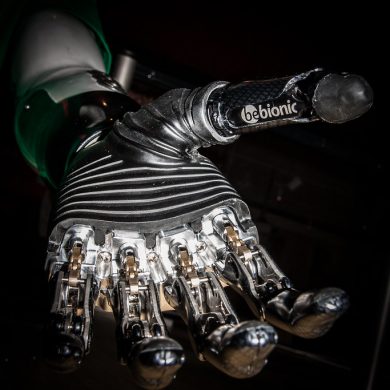Whether you were lucky enough to attend one of Taylor Swift’s Eras Tour concerts this year or simply watched from the sidelines as seemingly everyone you know posted an Instagram photo decked out in friendship bracelets and a hot pink cowboy hat, I’m sure you were witness to (or a victim of!) “Taylor Fever.” But why do we have such strong emotional reactions to her music or music in general? What does biology have to say about the joy we, and the 70,000 other people in the stadium, feel when we listen to music?
How does music trigger the brain’s reward system?
“It’s like I got this music in my mind saying it’s gonna be alright”
As it turns out, listening to music triggers the reward system in the human brain. This means that when we encounter something rewarding, like music, a region in the midbrain called the Ventral Tegmental Area is stimulated to produce dopamine. Dopamine is a neurotransmitter that plays a role in mood, learning, attention, and–most relevant here–reinforcement. The so-called “dopamine rush” we get from something that brings us joy keeps us coming back for more. Once dopamine is released, it travels through the mesolimbic pathway to the Nucleus Accumbens (NAc) located in the forebrain. When it binds to receptors there, we feel pleasure. In fact, it’s this process that’s responsible for the sensation of “chills” while listening to music, but we’ll get to that later! Once we associate pleasure with a certain stimulus, we seek out that stimulus again and again (Guy-Evans). This is the same neurological response associated with behaviors like eating and sex—behaviors required for an organism to survive and reproduce. Listening to music, however, is not quite on that level. All organisms must exhibit evolutionarily necessitated behaviors, but I don’t see chimpanzees screaming “You Belong With Me” at the top of their lungs.
So, what makes humans different? As organisms get more complex and more capable of higher-order thinking, the activities that can trigger the brain’s reward system get more complex as well. Specifically, it’s higher-order processing by the cerebral cortex (the region responsible for language, thought, emotion, and personality) that determines what humans find rewarding. Humans can connect stimuli that don’t directly relate to survival with survival in a way that other animals cannot. Music fosters human connection (“Taylor, you’ll be fine!”), and, therefore, survival. Listening to music triggers the same dopamine response as these other biologically rewarding stimuli, which connects them. Thus, something like music, which is integral to human communities and social behavior but not necessarily a requirement for survival, can still elicit the same response as something that is required for survival.
Dopamine is released as a response to a stimulus, leading to pleasure. Specifically, certain cells are responsible for releasing dopamine in conjunction with pattern prediction. Music is, of course, built upon patterns. For example, the click of a metronome can be organized into patterns, such as the two-beat feel of a march or the three-beat feel of a waltz. Similarly, the repetition of a certain melody, perhaps the chorus of a song (“You got that James Dean daydream look in your eyes”), adds a periodicity to what is perceived and keeps the brain anticipating the next repetition. It’s this cycle of anticipation and reward that is so addictive, as it takes advantage of both our brain’s affinity for patterns and the reinforcement cycle created by dopamine release.
How does this contribute to emotional response?
“And I never knew I could feel that much”
All of this is happening in the brain when we listen to music, leading to the emotions we feel. One aspect of our emotional response to music is the way we identify with it. There’s a system in the brain called the Default Mode Network (DMN) that is active when the brain is not actively paying attention to something. It’s associated with introspection, self-awareness, and understanding others and is active during times of “mind-wandering.” As one study found, it’s also active while listening to music one enjoys. Listening to music in general corresponds with increased activity in the DMN, but the most increased activity was measured while study participants listened to music they enjoyed. Increased DMN activity means music is tied to the states and behaviors associated with the DMN, as outlined above.
In a different study, emotional arousal was measured in conjunction with participants’ reported pleasurable experiences listening to music. Activity in the Sympathetic Nervous System (activated for a “fight or flight response”) was used to measure emotional arousal. Sure enough, increased Sympathetic Nervous System activity correlated with increased participant pleasure ratings. Furthermore, when one experiences a “peak experience” (more on that later) while listening to music, there is a higher dopamine response in the mesolimbic striatum, the same pathway associated with the reward discussed above! This is further supported by the fact that when comparing music that does provoke a pleasurable response (for me, Folklore), to music that does not, there is greater NAc activity, a.k.a. greater reward value! These studies illustrate that subjective ratings of pleasure correlate with the neurobiological process of dopamine release in the brain.
Oddly enough, “pleasurable” doesn’t necessarily mean happy. Listening to sad music can lead to the same pleasure response as happy music. For example, it’s possible to get chills (pleasurable) while listening to sad music. One potential explanation for this bizarre paradox is the so-called “consoling” reaction, the comforting response certain hormones cause when you cry. This response is the reason you might feel better after crying (or listening to All Too Well (10 Minute Version) (Taylor’s Version)). Another paradox presented by the brain’s response to music is that music can be both energizing and calming (think: your workout playlist vs. a lullaby, or 22 vs. peace). This is because music is capable of manipulating arousal. In a study conducted on mothers, arousal levels were lower while singing calming songs to their babies. While singing playful songs, arousal levels were higher. This is potentially due to music’s impact on the amygdala, a brain structure closely associated with emotion.
Music has the ability to impact many different neurobiological processes, leading to the wide variety of emotional states it can provoke.
Why do we get chills while listening to music?
“But can you feel this magic in the air?”
And, when music impacts us emotionally, we may get chills/thrills/goosebumps (survey’s out on the most popular word). Chills are a manifestation of what is known as a “peak experience”, as mentioned above. They correlate with the peak emotional response to a piece of music. Chills are also associated with different observable traits of Sympathetic Nervous System arousal, like an increased heart rate. Thus, chills are often used by scientists in this field as a marker of emotional arousal. Chills can result from both positive and negative experiences (like chills from fear). For simplicity’s sake, pleasurable chills are referred to as “frisson”, a French word for the pleasurable variation of this sensation. Various studies have determined that at least half of the population experiences frisson from music, with some studies putting the number closer to three-fourths. This number is higher in musicians, perhaps because those who experience chills are more likely to pursue music.
Chills, like the pleasure responses outlined above, are also connected with Sympathetic Nervous System arousal. In people who experience frisson, the parts of the brain responsible for auditory processing and those responsible for emotion are more connected. Frisson correlates with increased blood flow in the NAc, the same structure associated with dopamine release. So, the dopamine rush we get while listening to pleasurable music leads to a physiological reaction. In addition to NAc activity, the moments preceding frisson are accompanied by activity in the caudate, another structure involved with reward. In fact, the blood flow patterns in the brain during musical frisson show a striking similarity to those of addiction. The same sort of “craving” takes place. In musicians and extreme Swifties (holders of the over 4.35 million Eras Tour tickets sold), that craving is intense.
There are many theories for why this happens. One theory suggests that the human ear is attuned to the sound of an infant crying, leading to a physiological response, like chills. Having a response like this means that humans are more likely to connect with a crying infant, which, naturally, is of evolutionary importance. This phenomenon is then extended to other auditory stimuli, like music. Another theory suggests that frisson results from the contrast generated by a positive response when preceded by a negative one. For example, when riding a rollercoaster, initial sensations of fear are soon overrun by joy as you realize your life isn’t actually in danger. This, too, could lead to frisson. According to this model, unexpected sounds, as presented by music, trigger a fear response that is quickly replaced by pleasure once the stimulus is recognized as music. The contrast here makes the positive response more potent, leading to frisson. Goosebumps, or piloerections, are also commonly a fear response, suggesting that this fear response is connected to frisson. According to this theory, it’s the combination of high fear and high pleasure that causes the sensation.
Conclusion
“I can see the end, as it begins”
So, next time you find yourself scream-singing along to 1989 (Taylor’s Version), know that you have your brain to thank! And, when you find yourself tapping through your Spotify Wrapped, wondering how on Earth you listened to the same song that many times, know that our brain’s reward system is hard at work, making you come back time and time again.
https://www.jstor.org/stable/42706677
https://www.simplypsychology.org/brain-reward-system.html
https://www.health.harvard.edu/mind-and-mood/dopamine-the-pathway-to-pleasure
https://www.jstor.org/stable/40351765?seq=4
https://www.jstor.org/stable/24755599
https://www.ncbi.nlm.nih.gov/books/NBK92781/
https://daily.jstor.org/why-do-we-listen-to-sad-music/
https://www.sciencedirect.com/science/article/pii/S157106451730163X
https://www.nature.com/articles/nn.2726
https://www.bbc.com/culture/article/20221124-why-music-can-give-you-chills-or-goosebumps
https://journals.plos.org/plosone/article?id=10.1371/journal.pone.0007487
https://www.researchgate.net/publication/285500789_Musical_Expectancy_and_Thrills
https://neurosciencenews.com/music-chills-neuroscience-6167/
https://www.frontiersin.org/articles/10.3389/fpsyg.2014.00790/full
https://open.spotify.com/track/3pv7Q5v2dpdefwdWIvE7yH?si=4xTl3OZeRGSMWG4eM0PAZw
https://open.spotify.com/track/22bPsP2jCgbLUvh82U0Z3M?si=2KzL5kV5TIe8HEczs264UA
https://open.spotify.com/track/1K39ty6o1sHwwlZwO6a7wK?si=c1BiTqwIQlueVzYlDdUftg
https://open.spotify.com/track/3Vpk1hfMAQme8VJ0SNRSkd?si=bc0bf4efe3e149e1
https://unsplash.com/photos/taylor-swift-album-RjD01Is-KnI


